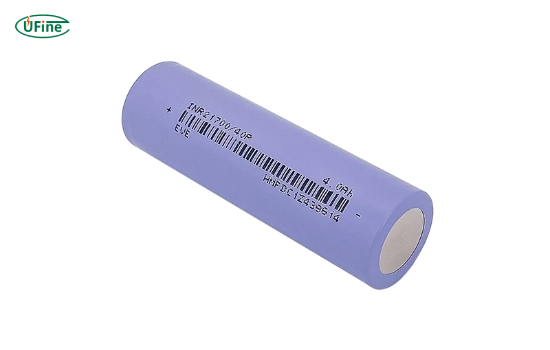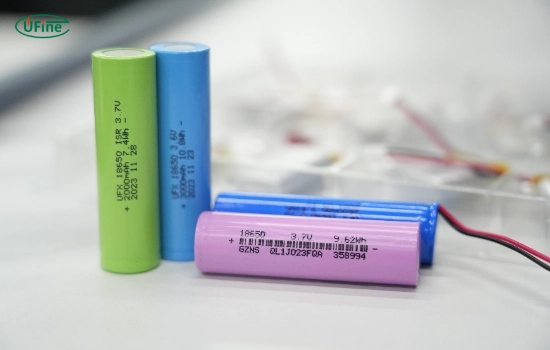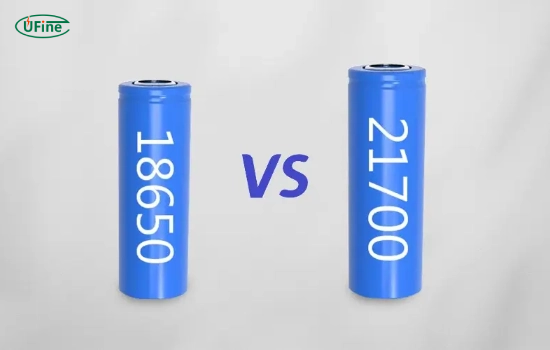What is the difference between 21700 and 18650 battery? This article aims to compare their advantages, drawbacks, applications, and definitions to empower consumers to make informed choices. Explore the nuances between these battery types to facilitate better decision-making in energy storage solutions.
Part 1. What is a 21700 battery?
The 21700 battery is a big step in lithium-ion technology. It’s 21mm wide and 70mm long, larger than the 18650. This means more power and longer use for high-demand devices. With better power and less heat, the 21700 battery is a modern solution for high-performance electronics.
Advantages of 21700 battery
- Enhanced energy density: The 21700 battery offers a higher energy density compared to its predecessors, enabling it to store more energy within a similar size. This translates to longer operational times for devices without frequent recharging.
- Increased power output: Its larger physical size allows for a higher power output, catering to devices that demand more energy. This ensures sustained and efficient performance, especially in high-drain gadgets.
- Improved thermal management: The larger format aids in better heat dissipation, reducing the risk of overheating during intensive usage. This feature enhances safety and contributes to prolonged battery life.
- Future-proof technology: Positioned at the forefront of innovation, the 21700 battery is considered future-proof, offering better efficiency and performance for upcoming devices and industries.
Disadvantages of 21700 battery
- Compatibility challenges: The larger size of the 21700 battery may not fit into devices designed for smaller batteries like the 18650, limiting its application in certain gadgets and technologies.
- Size limitations: The increased size might also restrict its use in smaller, compact devices where space optimization is critical, affecting its versatility.
21700 Battery applications
- Electric vehicles (EVs): The 21700 battery’s higher energy density and power output make it ideal for electric vehicles, extending driving ranges and improving overall performance.
- Power tools: Its ability to deliver higher power output suits various power tools, ensuring extended usage and enhanced efficiency in construction and industrial applications.
- High-performance electronics: Devices like high-powered flashlights, drones, and advanced electronics benefit from the 21700 battery’s extended power supply and efficiency.
- Renewable energy storage: In renewable energy systems such as solar power storage, the 21700 battery’s capacity and efficiency contribute to better energy utilization and storage without relying on the grid.
Part 2. What is an 18650 battery?
The 18650 battery is a common lithium-ion cell, known for its 18mm width and 65mm length. It’s used in many gadgets due to its small size. Even though it’s little, it works well and is good for devices like laptops, flashlights, and e-cigarettes. You can find it easily and it usually doesn’t cost too much.
Advantages of 18650 battery
- Compact form factor: The 18650 battery’s smaller size allows it to fit into various devices where space is limited, making it a versatile choice for compact electronics without compromising performance.
- Widespread availability: Being in the market for an extended period, the 18650 battery is easily accessible and commonly found, often at an affordable price point, making it a cost-effective solution for many consumers.
- Versatility in applications: Its compatibility with a wide range of devices such as laptops, flashlights, portable chargers, and e-cigarettes showcases its adaptability and reliability across diverse electronic platforms.
- Balanced performance: Despite its smaller size, the 18650 battery delivers decent performance, striking a balance between capacity, power output, and longevity, meeting the requirements of various consumer electronics.
Disadvantages of 18650 battery
- Limited energy density: Compared to newer battery models like the 21700, the 18650 battery has a lower energy density, which restricts its capacity to store energy, leading to shorter usage durations in high-demand devices.
- Lesser power output: Its smaller size results in a comparatively lower power output, which might not meet the energy demands of high-performance gadgets, limiting its application in such devices.
18650 Battery applications
- Portable electronics: The 18650 battery finds extensive use in portable electronics like laptops, tablets, and handheld gaming devices due to its compact size and adequate performance.
- Flashlights and power banks: Its versatility extends to powering high-intensity flashlights and portable power banks, where its balance between size and performance is well-suited.
- Electric vehicles (EVs): Though less common, some electric vehicles utilize 18650 batteries in their battery packs, contributing to their energy storage systems.
- Medical devices: The 18650 battery’s reliability and compatibility make it suitable for various medical devices like portable oxygen concentrators, ensuring dependable power sources for critical equipment.
Part 3. What is the difference between 21700 and 18650 batteries?
Size
The primary difference lies in their physical dimensions, where the 21700 battery measures 21mm in diameter and 70mm in length, while the 18650 battery is slightly smaller at 18mm in diameter and 65mm in length. This size variation impacts their compatibility with devices and the amount of energy they can store.
Energy density and capacity
The 21700 battery exhibits a higher energy density compared to the 18650, allowing it to store more energy within a similar space. This translates to extended usage times in devices that require sustained power. The larger size of the 21700 battery contributes significantly to its enhanced energy capacity.
Power output and performance
Due to its larger physical size, the 21700 battery can deliver higher power output, making it suitable for high-drain devices that demand more energy. On the other hand, the 18650, while smaller, provides a decent performance but might not suffice for devices with intense power requirements.
Applications and usage
The differences in size, energy capacity, and power output determine their applications. The 21700 battery finds its place in high-performance devices such as electric vehicles, power tools, and gadgets requiring extended power and efficiency. Meanwhile, the 18650 battery caters to a broader range of devices due to its smaller size, fitting well into portable electronics like laptops, flashlights, and medical devices, where space optimization is crucial.
Part 4. 18650 vs. 21170: Specification
This table outlines the comparison between the 21700 and 18650 batteries based on nominal voltage, nominal capacity, actual capacity, operating voltage range, cut-off voltage, charging voltage, charging current, charging time, charge-discharge cycles, and charging method.
|
Specification
|
21700 Battery |
18650 Battery
|
|
Nominal Voltage |
3.6V |
3.6V |
|
Nominal Capacity |
4000mAh |
3000mAh |
|
Capacity Range |
3500-4000mAh |
2500-3000mAh |
|
Operating Voltage |
2.5-4.2V |
2.5-4.2V |
|
Cut-off Voltage |
2.5V |
2.5V |
|
Charging Voltage |
4.2V |
4.2V |
|
Charging Current |
1-4A |
0.5-2A |
|
Charging Time |
3-4 hours |
2-3 hours |
|
Charge-Discharge Cycles |
Approximately 1000 |
Approximately 800 |
|
Charging Method |
CC/CV(Constant Current/Constant Voltage) |
CC/CV(Constant Current/Constant Voltage) |
Part 5. FAQs
-
Are 21700 and 18650 batteries interchangeable?
In most cases, 21700 and 18650 batteries are not directly interchangeable due to differences in size, shape, and specifications. However, some devices might accommodate both types with specific adapters or modifications. -
Does 21700 last longer than 18650?
Generally, 21700 batteries tend to have higher capacities compared to 18650 batteries. This higher capacity might provide longer runtime depending on the specific battery’s characteristics and the device’s power requirements. -
Which is better, 18650 or 21700 charger?
The choice between an 18650 or 21700 charger depends on the batteries you plan to charge. Ensure the charger is compatible with the specific battery type, capacity, and voltage requirements to charge it safely and efficiently. -
What is 21700 equivalent to?
A 21700 battery is equivalent to a larger-capacity and slightly larger-sized version of an 18650 battery. It offers higher capacity and potentially better performance due to its larger size and improved energy density.
Related Tags:
More Articles

Paper Battery vs. Flexible Battery: What’s the Difference and Which Is Better?
Paper vs. flexible batteries: learn the key differences, benefits, and which power source fits best for wearables, sensors, and smart tech.
What to Know Before Buying a Tiny LiPo Battery for Your Project
Tiny LiPo batteries are powerful and compact. Learn how to choose the right one for your project with specs, safety, and charging tips.
Bloated LiPo Battery: Will It Explode?
Will a bloated LiPo battery explode? Discover the causes, risks, safety steps, and expert tips to avoid disaster and protect your gear. Must-read safety guide!
12V 100Ah Lithium Ion Battery Price: Full Guide
Learn about 12V 100Ah lithium-ion battery price, from cost ranges to best brands, hidden fees, and how to get the best deal. A must-read for smart buyers!
Resistance and Conductivity: What It Means for Your Lithium Batteries
Resistance and conductivity impact lithium battery performance, lifespan, and safety—learn how they work and why they matter.






